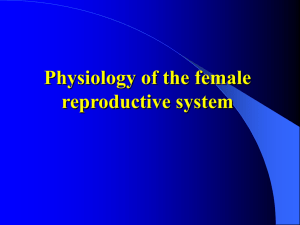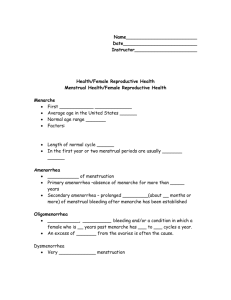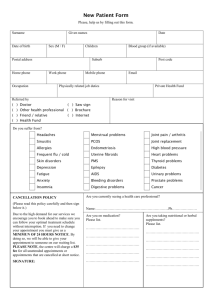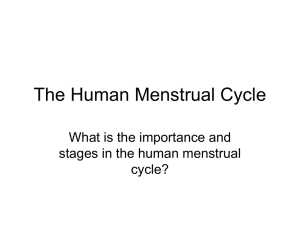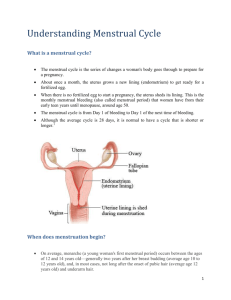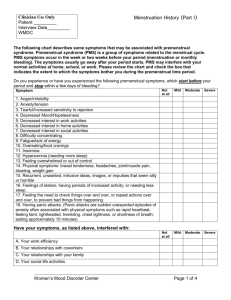Agnolyt solution
advertisement
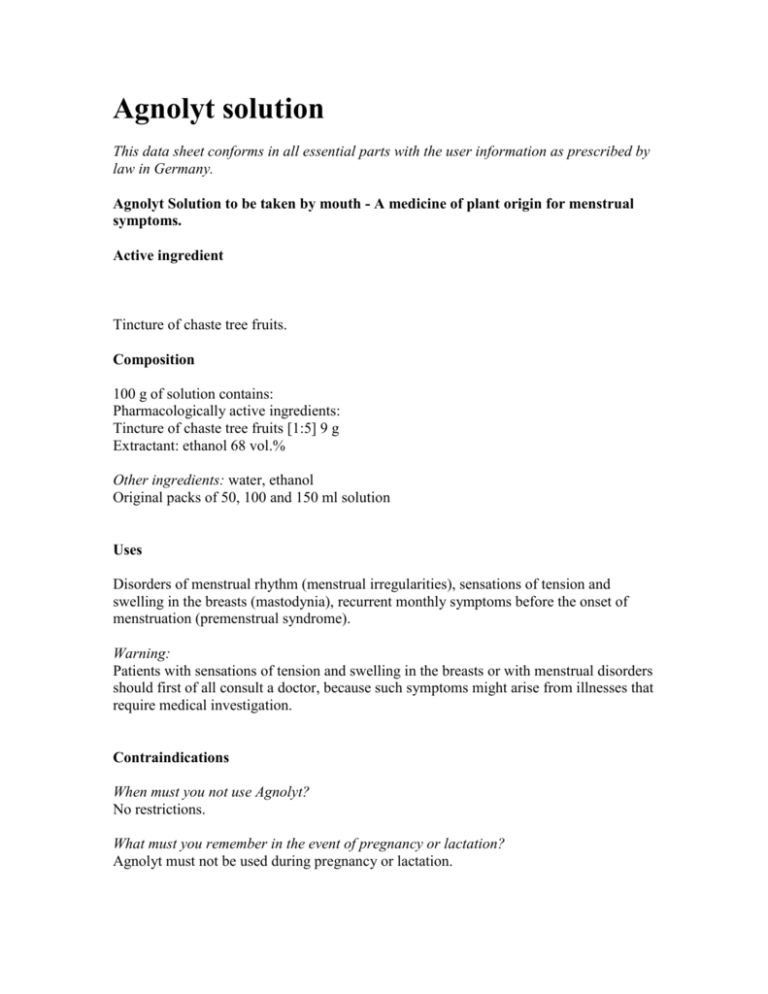
Agnolyt solution This data sheet conforms in all essential parts with the user information as prescribed by law in Germany. Agnolyt Solution to be taken by mouth - A medicine of plant origin for menstrual symptoms. Active ingredient Tincture of chaste tree fruits. Composition 100 g of solution contains: Pharmacologically active ingredients: Tincture of chaste tree fruits [1:5] 9 g Extractant: ethanol 68 vol.% Other ingredients: water, ethanol Original packs of 50, 100 and 150 ml solution Uses Disorders of menstrual rhythm (menstrual irregularities), sensations of tension and swelling in the breasts (mastodynia), recurrent monthly symptoms before the onset of menstruation (premenstrual syndrome). Warning: Patients with sensations of tension and swelling in the breasts or with menstrual disorders should first of all consult a doctor, because such symptoms might arise from illnesses that require medical investigation. Contraindications When must you not use Agnolyt? No restrictions. What must you remember in the event of pregnancy or lactation? Agnolyt must not be used during pregnancy or lactation. Precautions and warnings What precautionary measures must be remembered? This medicine contains alcohol 58 vol.%. When taken in accordance with the dosage guidance, each dose (40 drops) will contain 0.8 g alcohol. A health risk from alcohol exists in patients with liver diseases, alcohol-related conditions, epilepsy or brain damage, among other conditions. Agnolyt can interfere with the action of other medicines. If the use of Agnolyt solution is considered inadvisable, Agnolyt capsules offer an equally effective alternative. Interactions with other drugs What other medicines affect the action of Agnolyt? If you are taking any other medicines you should consult your doctor before starting Agnolyt because there is some evidence of reciprocal weakening of the action when it is taken at the same time as dopamine receptor antagonists. Please remember that this advice can also apply to recently administered medicines. Dosage guidance, mode and duration of administration The following instructions apply unless your doctor has directed otherwise. Please adhere to the directions for use, otherwise Agnolyt cannot act properly. How much Agnolyt should you take and how often? Unless otherwise directed, take 40 drops once daily. How and when should you take Agnolyt? Take the drops in a small amount of liquid every morning. How long should you go on taking Agnolyt? Agnolyt should be taken for several months without a break. Once the symptoms have improved, treatment should be continued for a few weeks. Incorrect Use and Overdoses What should be done if Agnolyt has been inadvertently taken in unduly large amounts? The signs of overdosage and poisoning are not yet known. Intake of this medicine in large amounts may cause alcohol poisoning, especially in children; in such an event life is at risk and a doctor must be consulted immediately. Consumption of the entire contents of a bottle would mean an alcohol intake of about 25, 49 or 74 g depending on the bottle size. Side effects What side effects may occur during the use of Agnolyt? There have been itching skin eruptions with blistering in occasional instances. If you observe any side effects not mentioned in this package insert please report them to your doctor or pharmacist. Information and statements regarding storage life The expiry date of this pack is printed on the carton and the label. Do not use this pack after that date! Date of information as at December 1996. Further information Agnolyt is a medicine of purely plant origin. Acting on a natural basis, it regulates the monthly cycle and alleviates or completely relieves premenstrual symptoms occurring one to two weeks before menstruation. This is how the female cycle operates: The menstrual cycle has only one purpose: to prepare for a pregnancy. Every month one ovum matures in one or other of the ovaries. It is released when an ovarian follicle ruptures and it is taken up by the Fallopian tube, where it may be fertilised by male sperm cells. The site of the ruptured follicle in the ovary is marked by a kind of scar which, because of its yellowish colour, is called the corpus luteum. This corpus luteum or yellow body, in response to orders from the brain, produces the corpus luteum hormone progesterone. This hormone ensures adequate blood flow through the mucosa of the uterus so that the fertilised ovum can become implanted in the uterus and the pregnancy can continue. If fertilisation does not take place, the corpus luteum shrinks, hormone production decreases, the uterine mucosa no longer has an adequate blood supply and is ultimately cast off; menstrual bleeding begins. How do menstrual disorders originate? The control of hormones and their interplay are extremely complicated and their balance can all too easily be disturbed. An inadequate signal from the brain or unduly low hormone production by the ovaries can upset the sequence of events in the menstrual cycle. Should these disorders cause the cycle to be too short or too long, such abnormalities are spoken of as disorders of menstrual rhythm. In such cases the cause is frequently to be found in inadequate development and maturation of the corpus luteum, with consequent interference with progesterone release. When problems arise in the days before the period: The characteristic symptoms which occur in the days before menstruation likewise point to derangements of the hormonal regulatory circuit. Many women find that their equilibrium is upset on the days before menstruation begins. Some women feel physically unwell, with pain in the lower abdomen, and tension or pain in the breasts, and they feel swollen up, tired or have headaches. Other women are troubled by psychological disorders such as irritability, nervousness, depression and apathy. Almost every woman experiences such symptoms occasionally to a greater or lesser degree. When the problems occur regularly before each menstrual period and then disappear spontaneously when bleeding commences, the condition is spoken of as the 'premenstrual syndrome' or PMS. The cause is frequently to be found in an upset in the interplay between oestrogen and progesterone, so that their balance is disturbed; for example, the progesterone level may be too low. How does Agnolyt work? Agnolyt is a natural product, free from hormones. The active ingredients are extracted from the fruit of the chaste tree. The chaste tree is an aromatic shrub or small tree, 2 - 4 metres in height, growing wild in the Mediterranean area, the Crimea and Central Asia. Investigations in laboratory animals have shown that the action of Agnolyt is based on its power to stabilise the female hormonal regulatory cycle. Fine tuning between the brain (the pituitary gland) and the ovaries is improved. The cycle stabilises and the symptoms are alleviated or completely disappear. The same applies to the troublesome symptoms of PMS. Please remember that this regulatory biological intervention cannot take effect overnight, and you must therefore take Agnolyt regularly for several months before you can expect a response. If the intake of alcohol should be forbidden, Agnolyt capsules provide an equally effective alternative.

